There has never been a better time to develop an Indoor Air Quality Management Plan for your business. As employees return to in-person work experiences, staying on top of indoor air quality can ensure occupant wellbeing and reduce the risk of airborne disease transmission, for instance.
In today’s blog, we will explore the steps you can take to assess, manage, and improve indoor air quality effectively. Follow our 5-step indoor air quality management plan to gain insight into the importance of indoor air quality and how you can take control of yours.
Step 1: Understanding Indoor Air Quality
Understanding what Indoor Air Quality is and what kinds of factors can contribute to it is the critical first step in our indoor air quality management plan.
Indoor air quality (IAQ) is broadly defined by the Environmental Protection Agency (EPA) as “the air quality within and around buildings and structures, especially as it relates to the health and comfort of building occupants.”
In other words, IAQ is not one single figure or idea. Instead, it is a complex set of interactions between a number of factors that all combine to create a breathing environment. First and foremost, Indoor Air Quality matters because of the people that interact with it.
What are the 5 main factors that affect indoor air quality?
The primary factors that impact IAQ are:
- Building Ventilation: the rate and efficiency of air renewal in a building
- Construction/Painting Chemicals: the parts and substances used in construction and decoration
- Location of the Building: whether urban, suburban, or rural, each environment contributes to air quality differently
- Season/Environmental Factors: certain parts of the world have more prominent environmental/weather patterns that affect IAQ
- Occupants: the number, habits, and possessions of individuals interact with environments in various ways
Step 2: Understanding Pollutants
Improving indoor air quality starts with understanding what can have a detrimental impact on it. There are major pollutants and sources of air pollution that most directly affect indoor air quality in a collaborative workspace or office building.
What are the four major indoor air pollutants?
The primary compounds that cause air pollution are:
- Particulate matter: primarily dust particles, classified in fine and coarse sizes
- Volatile organic compounds (formaldehyde): common industrial solvents that evaporate in open-air conditions but may linger in enclosed spaces. Formaldehyde is a common byproduct of building materials and a probable carcinogen.
- Carbon dioxide: colorless, odorless gas produced, among other ways, by exhalation. Overpopulated, poorly ventilated spaces may have higher levels of carbon dioxide.
- Carbon monoxide: colorless, odorless, gas produced by leaking heating systems, generators, or fuel-burning appliances. Extremely dangerous.
While those are among the most common pollutants, there are many other chemicals and compounds that may negatively affect IAQ. Other important pollutants to keep an eye on:
- Radon: naturally occurring radiation linked to the outside environment of a building
- Nitrogen Dioxide: compound produced by heavy road traffic or fuel-burning combustion appliances
- Asbestos: toxic mineral compound historically used in building insulation. Asbestos is frequently found in buildings built before the 1970s.
- Lead: a poisonous chemical used in paints until the 1970.
All of those compounds and chemicals are linked to specific sources in indoor spaces. Understanding the correlation between polluting sources and pollutants is an essential step in executing our indoor air quality management plan.

What are the major sources of indoor air pollution?
The most prominent sources of indoor air pollution are:
- Fuel-burning combustion appliances and tobacco products: any appliance or product that burns, produces smoke, and releases certain gases
- Building materials: older buildings might be impacted by deteriorated asbestos or lead products, while brand-new buildings may be impacted by construction chemicals or pressed wood byproducts
- Cleaning and maintenance products: certain chemicals used in industrial cleaning products, for example, have a significant impact on IAQ in the short term
- Environmental byproducts: excess moisture, radon radiation, local pollution, and the use of pesticides can all impact air quality detrimentally
Step 3: Identifying Problems
Understanding the factors contributing to poor indoor air quality is only part of finding a solution. To successfully counter problems in IAQ, we need to be able to identify when there is a problem.
What are the symptoms of poor air quality?
Identifying poor air quality begins with the building occupants. If multiple employees or staff complain of headaches, fatigue, shortness of breath, or nausea in the workplace, there is likely an air quality problem.
Being receptive to those complaints and understanding their correlation to IAQ is an important step in successfully executing the indoor air quality management plan.
Source: EPA (https://www.epa.gov/pmcourse/patient-exposure-and-air-quality-index)
Step 4: Improving Indoor Air Quality
When an indoor air quality problem arises, it is imperative to counteract it as quickly as possible. There are straightforward solutions to IAQ issues. Yet another reason to implement cautionary measures immediately.
How can I improve indoor air quality?
Because of the variety of factors and pollutants involved in indoor air quality assessment, you can approach improvements from many angles. But there are certain rudimentary steps that should become part of your regular building maintenance regardless of any acute issues.
- Replace HVAC filters regularly. In other words, keep your air ducts and ventilation system clean and up-to-date.
- Keep the floors clean. Particulate matter gathers on floors, especially carpeted ones. Keep them spick-and-span to avoid dust buildup.
- Maintain a healthy level of humidity. Allergens like dust mites and mold, for instance, thrive in high-moisture environments. Especially in the warmer months, regulating your interior moisture is key.
- Make your work environment smoke-free. The less smoke your interior is exposed to, the better the air quality. That simple fix may make a world of a difference.
CDC study of indoor air quality changes based on smoking policy in six counties of North Carolina:
Step 5: Continuously Monitoring Indoor Air Quality
Perhaps the most important step in the indoor air quality management plan is ensuring that any changes remain effective.
How can we control indoor air pollution?

While indoor air pollution remains a broad problem, there is a simple way to start taking control of its impact on your workspace. Establishing a monitoring system for IAQ in your building allows for preemptive knowledge and a greater sense of control over the health and safety of your work environment.
With qlair’s suite of indoor air quality monitoring products, you can stay continuously informed about the status of your building’s indoor air quality. By streamlining data collection and presentation, qlair centers employee and building wellbeing. It has never been easier to get a handle on your indoor air quality.

